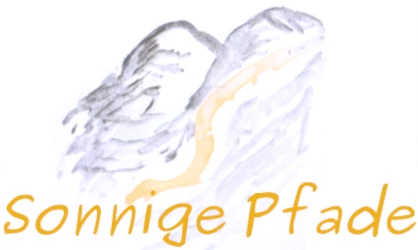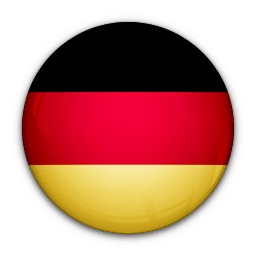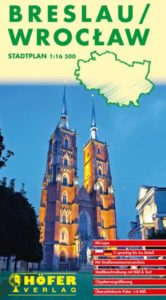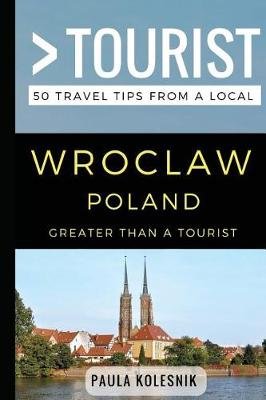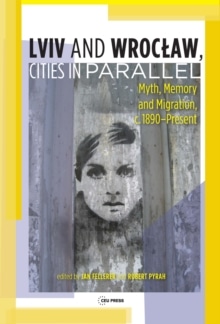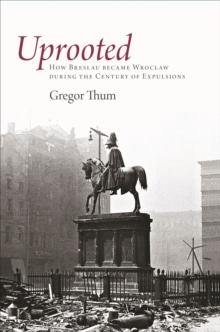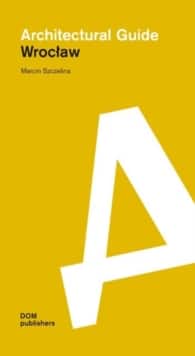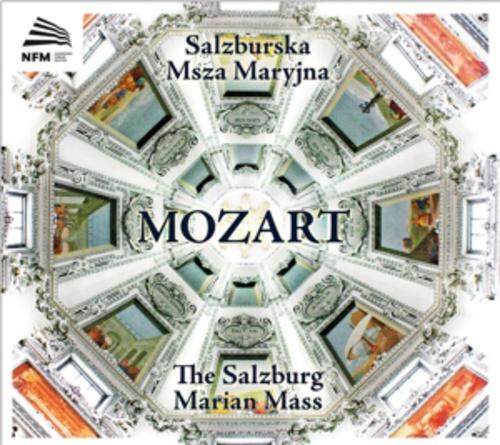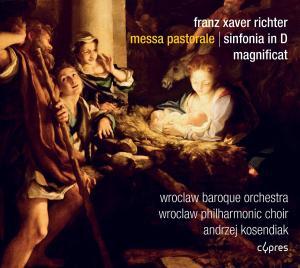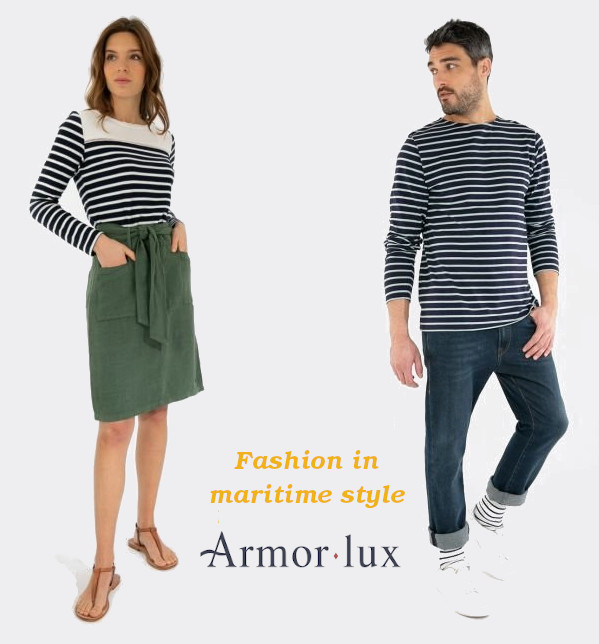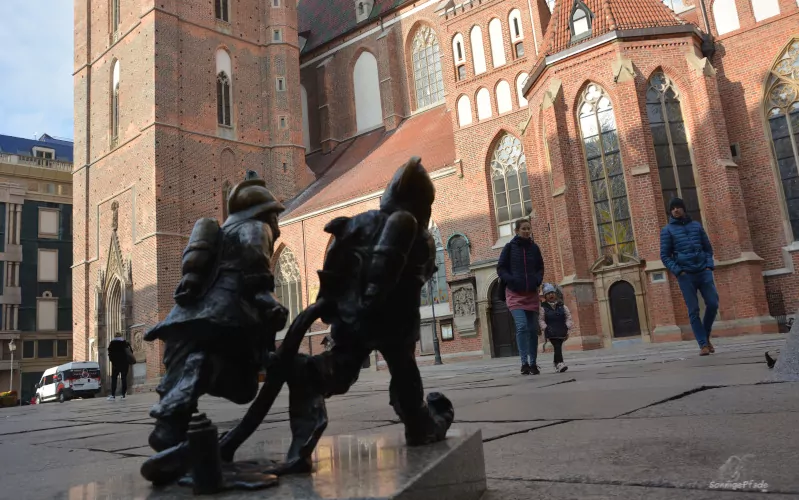
Follow in the footsteps of the dwarves who tell their stories everywhere in Wroclaw. Wherever you walk or stand, you will discover them and experience the variety of life in the streets of Wroclaw. Whether as a scholar dwarf at the university, as a Sisyphean dwarf pushing Globes along the street, as a blogger dwarf with a laptop on his knees, as a firefighter dwarf during a firefight at the Garrison Church or as a whole dwarf orchestra at the New Forum for Music – the dwarfs are the ambassadors of the city of Wroclaw. As such they now also visit the German twin city of Dresden.
[Contains *advertising]
Wroclaw, with the old german name Breslau, has had an eventful history. Unfortunately, it was often at the centre of warlike conflicts in Europe. Declared a fortress by Hitler, and thus massively destroyed, large parts of the old town were beautifully rebuilt by the Polish new settlers after the end of World War II. Wroclaw is a city of culture, which was awarded the „Coronation“ as European Capital of Culture 2016. Besides beautiful facades and sacral buildings in the old town (Stare Miasto) and the cathedral island, museums, exhibitions, theatre, opera and music clubs invite you to participate in the cultural diversity of the university city.
Table of content – Wroclaw and the Dwarvs
- Walk through the old tow and search for the Dwarfs!
- Pan Tadeusz House – Museum of the Polish National Epic „Pan Tadeusz“
- Outside the city center
- Other places worth seeing in Wroclaw
- Wroclaw Dwarfs – present everywhere
- Music and Theatre – culture all year around
- Travel tips for Wroclaw
- Tourist information on site
- Best travel time and weather
- Timezone of Wroclaw
- Entry into Poland
- Journey to Wroclaw
- Local traffic in the city
- Accomodation in Wroclaw
- Dining in Wroclaw
- Polish Money
- Literature, Guide, City-Map…
- … and music of Wroclaw
Walk through the old town of Wroclaw and keep your eyes open for the dwarves
The market as a ring square
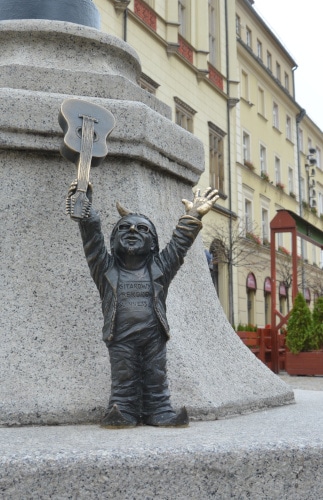
In the old town centre, the market with its detailed brick town hall is particularly characteristic for the image of the town. This forms the “ Great Circle„, the town hall stands on the square and thus limits a building complex to the south, which practically forms the market – centre. The free square is arranged in a ring around it, which gives the whole thing a special impression. You can practically walk around the market and move over four parts of the ring.
If you want to shorten, then two narrow passages cut through the middle quadrant of houses.
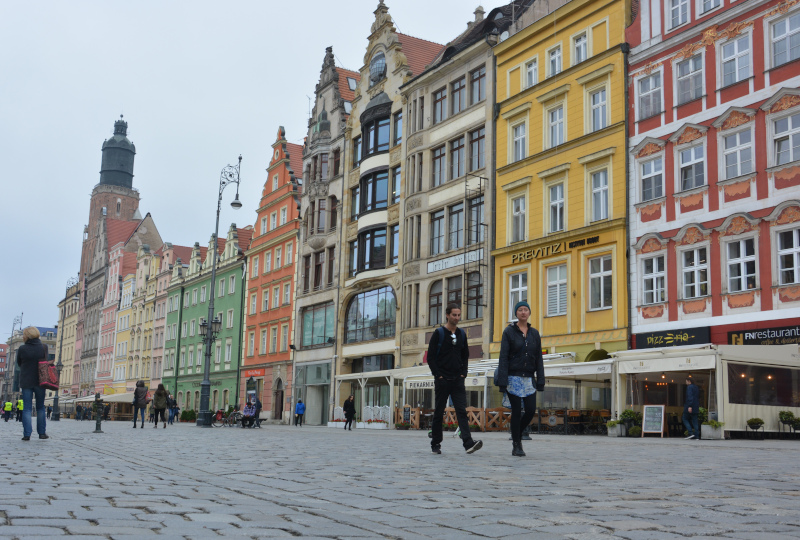
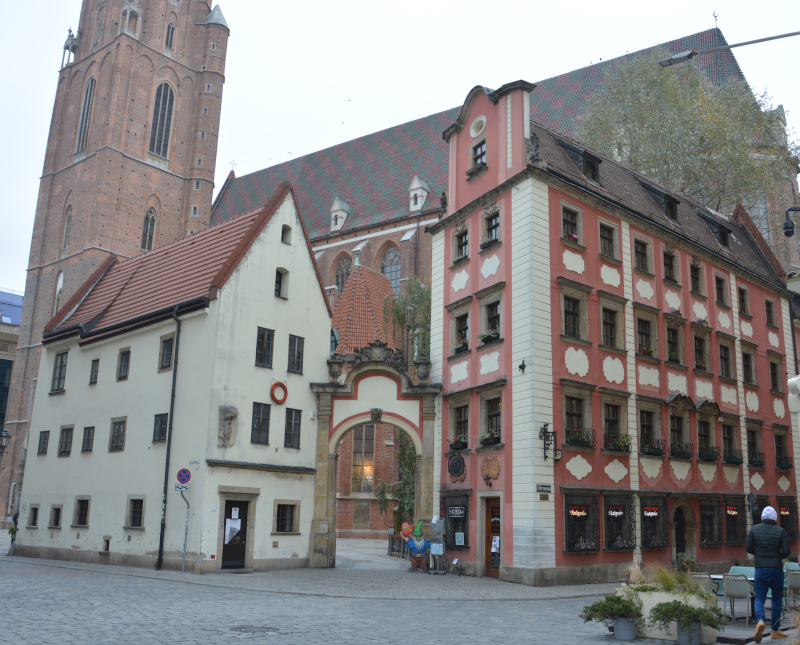
Two churches dominate the market quarter. At the north-west corner and the confluence of Oder Street (Odrzanska) the mighty Garrison Church, in front of it a group of even older houses with gate passage. And to the east of the market a cross street further on the church of St. Mary Magdalene. On the western side of the market there is a house with the Pan Tadeusz Museum, which will be mentioned later.
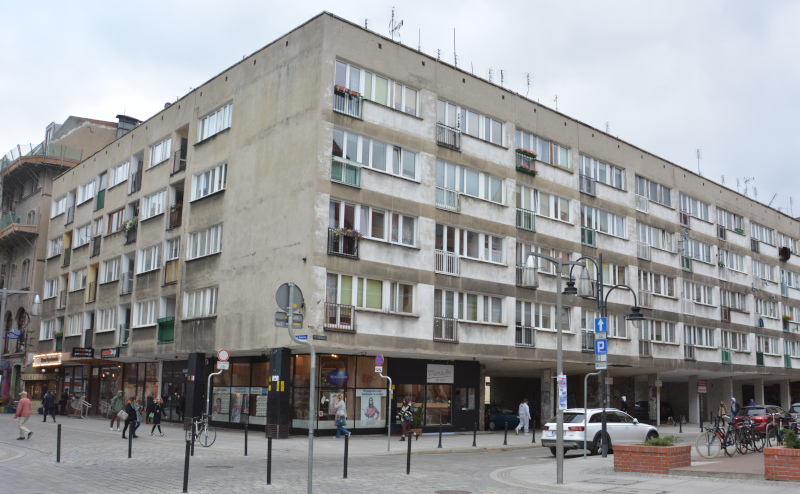
Otherwise, stylish town houses and historic department stores characterize this part of the city. A few modern seventies – houses may seem like a foreign body in between. They form a contrast that reflects the wounds of the city caused by the destruction of war.
At and around the market you can discover several of the Wroclaw dwarves. A guitar player on the stone bench of a lantern greets them. In front of the town hall a herald – dwarf announces the latest messages. And in the branching Świdnicka street a Syssifus dwarf rolls a stone ball uphill.
At the University of Wroclaw
If you go northwards along the Odrzanska, you will pass the „Jatki“ on the left. This former butcher’s lane now houses a number of galleries and art studios. At the entrance you will notice a „Monument to the slaughter animals“ with a bronze rooster, pig, goat and goose.
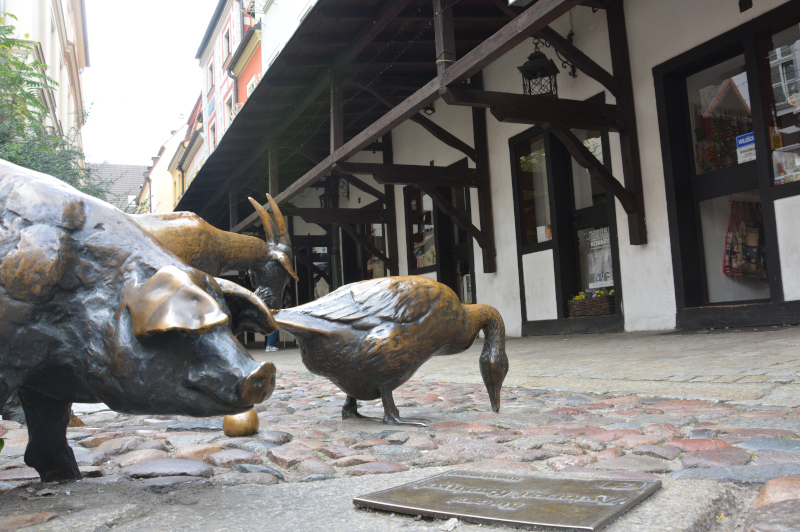
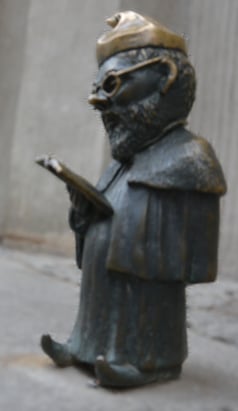
Further north, you will meet the Oder River, which branches into several branches in Wroclaw and also takes in some tributaries from the nearby Beskids. A bit to the right, the elongated main building of the University of Wroclaw in the „Austrian Baroque“ style dominates the bank. Next to the entrance gate to the university, Professor Dwarf is giving a lecture.
The university houses a university museum, the Aula Leopoldina – an impressive baroque hall and the concert hall Oratorium Marianum.

All over the Oder Islands
In front of the university building, the university bridge crosses the Oder arms. On the right hand side there are a few little or no built up islands between the arms of the river, which you can reach from the opposite river bank over small footbridges. This is a good way to relax a bit from the hustle and bustle of the city. Benches invite you to sit on the bank and have a look back over the river to the city. In summer there are boat rental offers and more or less all year round small sightseeing boats with which you can go on a small river cruise. From the sand island excursion boats go to the zoo and near the century hall.
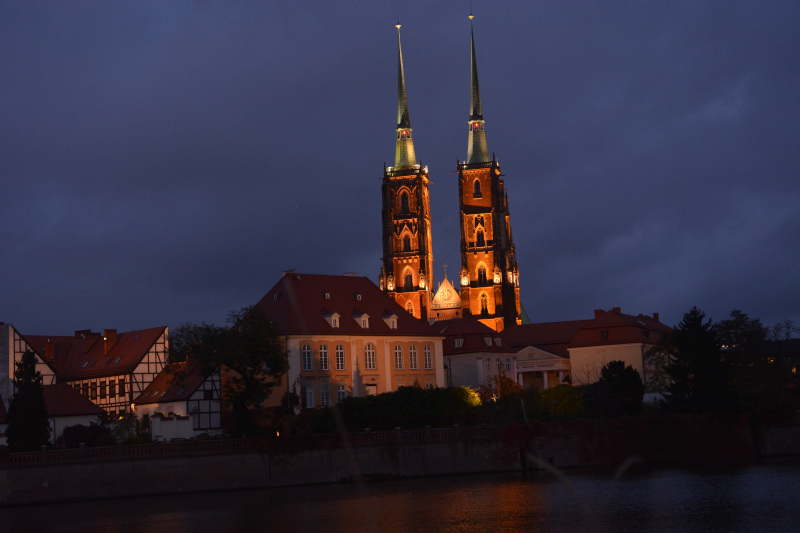
From the islands you can also reach the Cathedral island, which is no longer an island since an Oder branch was filled in. Here, the collegiate church of the Holy Cross and the cathedral of St. John the Baptist are particularly characteristic. The latter opens the tower with the viewing platform for visitors. In the Archdiocesan Museum you can see the chronicle of Henryków Monastery, which is a UNESCO World Heritage Site and contains the first written sentence in Polish.
North of the Cathedral Island is the Botanical Garden of Wroclaw.
National Museum and Panorama of the Battle of Raslawice
You can continue the tour at the eastern end of the clergymen’s quarter to the south over the „Most Pokoju“, the peace bridge. At the southern end of the bridge is the National Museum.
Not far from here, the Nazis flattened an entire city quarter during the last weeks of the war to build an airfield. A single plane landed there – to fly one of the Nazi big shots out of Breslau.
On the old town side, a promenade has been designed to make the way back pleasantly quiet and to give you the best views over the Oder to the cathedral island. A little south of the promenade in the Juliusza Sloweckiego park, a big ribbed round building catches the eye. In this rotunda a large panorama is presented – the Battle of Raslawice. Completed in 1894, the painting, 14 m high and 114 m long, immerses you in the battle. Originally erected in Lviv (Lwow), it was moved to Wroclaw in the course of the „western shift“ of Poland after the Second World War. The tickets are also valid for the National Museum and the Ethnographic Museum.
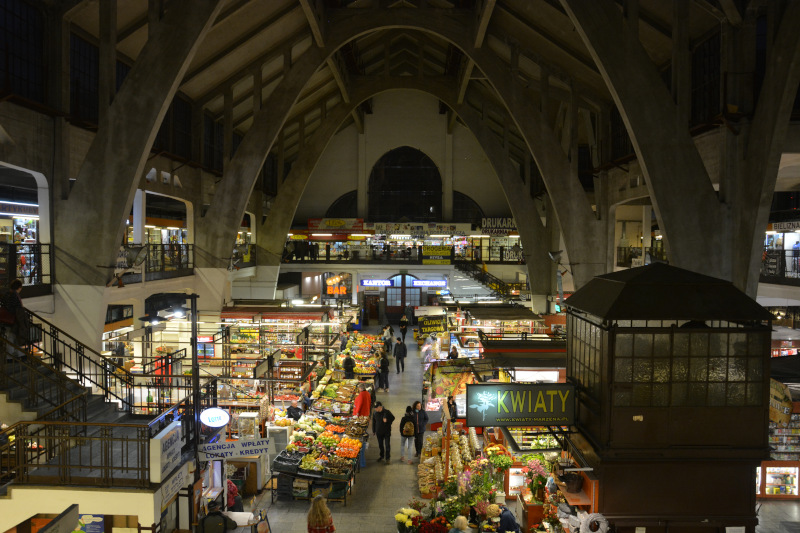
On the way back to the old town it is worth taking a look at the historic market hall. The outside of the market hall is brick clad, but the inside is a reinforced concrete construction dating from 1908. Markets and market halls are still used extensively in Poland to establish small businesses such as flower and food traders. The hall also looks correspondingly „flowery“. (Good possibility to enter a toilet on the way!)
Climbing the tower of the Wroclaw Garrison Church
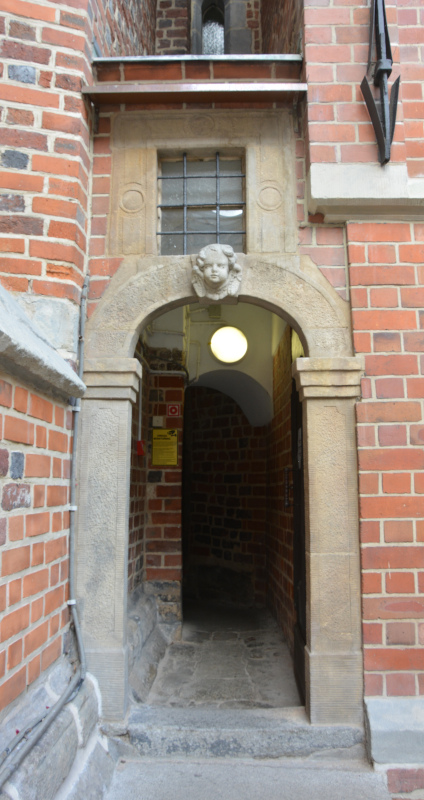
If you are not yet completely tired of paving, you can climb the tower of the garrison church at the market. The first part is a narrow, seemingly endless spiral staircase. Then the space widens, but unlike expected, not with beams and outer formwork, but in reinforced concrete supporting structure with concrete stairs. In the 50s and 60s the tower burned down several times, so that the upper part had to be rebuilt. From the open-air platform you have a good view over the market, the arms of the Oder and the whole huge city area up to the distant mountains in the south or forest areas in the northeast and west.
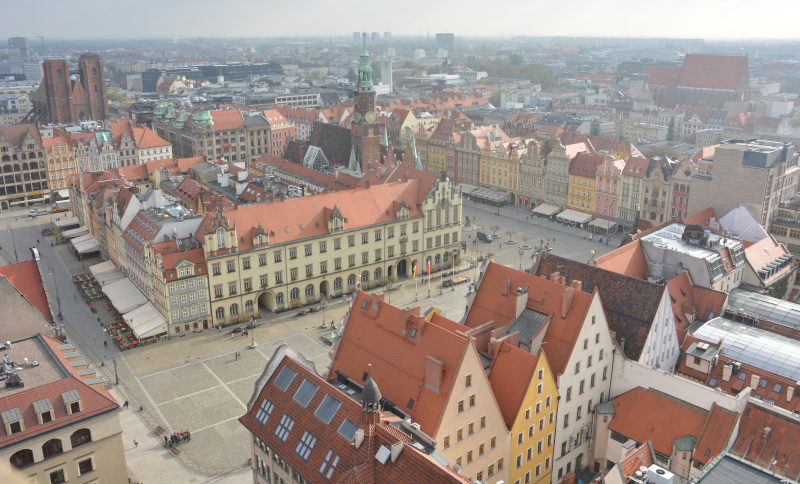
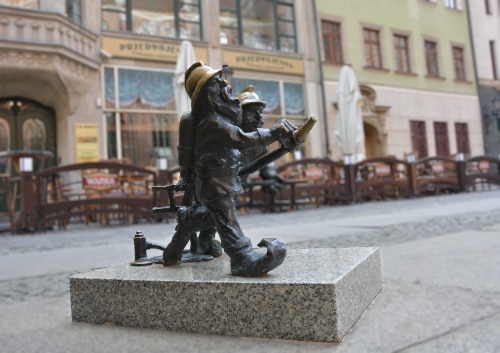
For a few minutes of relaxation, it is worth taking a look inside the church and taking a breather on one of the benches. The Garrison church is not as overloaded as so often in Polish catholic churches – unfortunately, the last time the nave burned in 1975, the biggest loss was probably the historic large Michael Engler organ, which stretched over several galleries on the west side. There you can still see a bare surface there today, which makes the loss almost physically tangible. In the meantime, a model of the organ, reconstructed according to drawings and photos, is available. A reconstruction is planned, for which donations are currently being collected. The fires of the church are remembered by the fire fighters – dwarves at the palce in front of the church, who fight the flames with syringe and ladder. This is truly symbolic – dwarves in view of the huge nave and high tower, without really having a chance against the fire.
The online magazine wroclaw.pl offers you more interesting pictures on a page about the Garrison Church – historical photos of the war destruction and fires in the 60s and 70s. Impressive views of the church and the city with a cross-fading of history and today are valuable historical testimonies, even if you do not understand the Polish text contributions about them. Especially a small photo gallery of the miniature reconstruction shows the former splendor of the Michael Engler organ.
Pan Tadeusz House – Museum of the Polish National Epic „Pan Tadeusz“
On the market, in the „House of the Golden Sun“ (Rynek 6), there is the Pan Tadeusz Museum, which belongs to the Ossolineum of the University of Wroclaw. (donor was the Count Ossoliński) The main part of the exhibition is dedicated to the life of the Polish writer Adam Mickiewicz, who lived in the period after the third partition of Poland, travelled throughout Europe including Constantinople and gained a wide range of experience in European countries during these journeys.
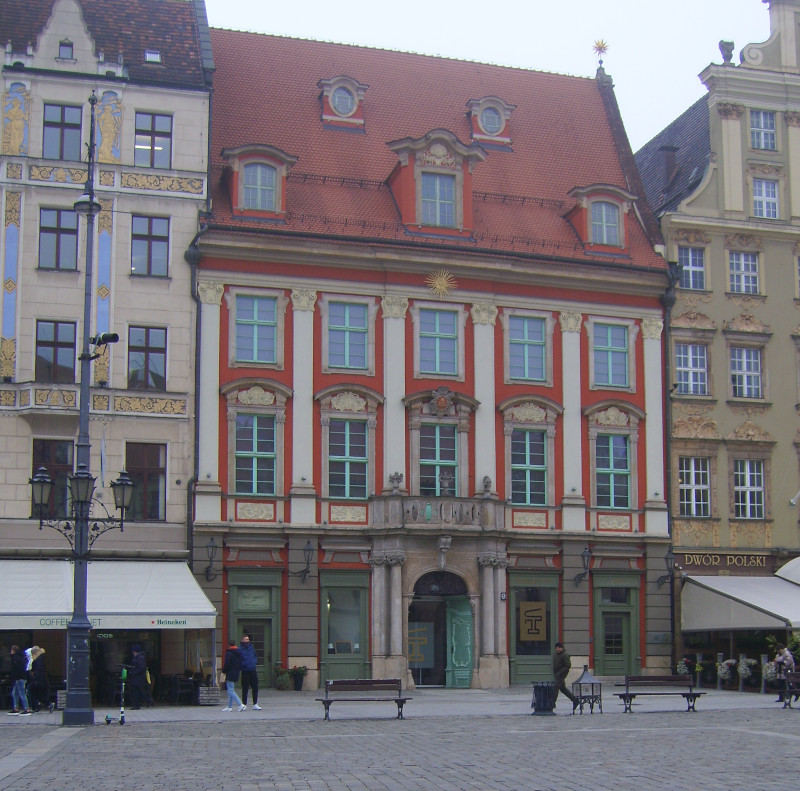
The main work of Adam Mickiewicz is the Polish national epic „Pan Tadeusz. The Last Feud in Lithuania“ (1834), which brings the life of the land aristocracy in Poland-Lithuania into poetry. „Pan Tadeusz“ (Mr. Tadeus) is still a compulsory subject in literature lessons in Poland, comparable to Goethe’s „Faust“ in Germany. In the Pan Tadeusz House the manuscript of Adam Mickiewicz is on display as the most valuable exhibit. By means of multimedia tablets and the exhibition, you can immerse yourself in Mickiewicz’s time, which European culture and art, fashion and way of life are a comprehensive mesh of historical horizons.
Patriotism in hard times
Another part of the exhibition in the Pan Tadeusz House is dedicated to the two Polish patriots Jan Nowak-Jeziorański and Władysław Bartoszewski in the „cabinet of contemporary witnesses„. They were active as opponents of the Nazi occupational forces in Poland – one as a member of the Armija Krajowa (the Polish Home Army), the other, among others, as a member of the Polish Jewish-Christian network Zegota for the support and rescue of Jewish fellow citizens.
Unfortunately, the Nazi occupation was followed by the domination of Moscow and the Polish Communist Party. Therefore both remained in resistance, meanwhile against the communist state power. They still did not see Polish independence in Mickiewicz’s sense realized.
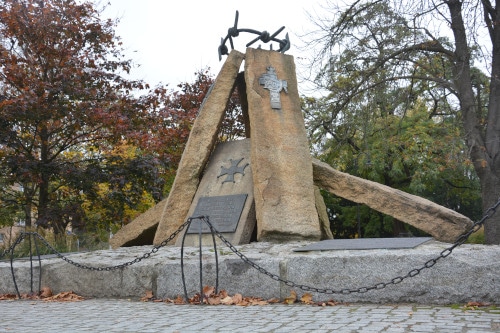
As a courier for the Polish government in exile, Nowak-Jeziorański was in London several times and stayed in western countries after the end of the war. Here he became a reporter for Poland, first on the BBC, then on the editorial staff of Radio Free Europe.
Bartoszewski was arrested in Poland shortly after the end of the war and served 6 years in prison. After the end of the immediate Stalin era he was rehabilitated and worked as a historian and publicist. At the beginning of the 80s he joined the Solidarnosc – movement and was arrested again. Through the efforts of friends he was able to leave prison and lived in the West for the time being, including as a guest-professor in Munich. After the end of the communist regime, he served, among other things, as ambassador to Austria and state secretary.
Service around the exhibition in the Pan Tadeusz House
There are multilingual audio guides for the entire exhibition in Pan Tadeusz House (included in the entrance fee), the multimedia displays are available in Polish and English. It is advisable to have read at least something in the „Pan Tadeusz“ beforehand to get an impression of the history and time of its creation. The verse – epic in english translation is available here free of charge as an eBook. At the entrance of the Pan Tadeusz House there is a cloakroom, bags and luggage up to a 35l rucksack can be stored in lockers. The house is handicapped accessible. If you want to make good use of the entire exhibition offer, you can easily plan a morning with 3-4 hours.
Outside the city centre of Wroclaw
The Century Hall and the Japanese Garden
In 1913 a „Hall of the Century“ (Hala Stulecia) was built in Wroclaw on the occasion of the centenary of the wars of liberation against Napoleon. It is a monumental circular building made of reinforced concrete. Its construction and development are explained in a multivisual exhibition.
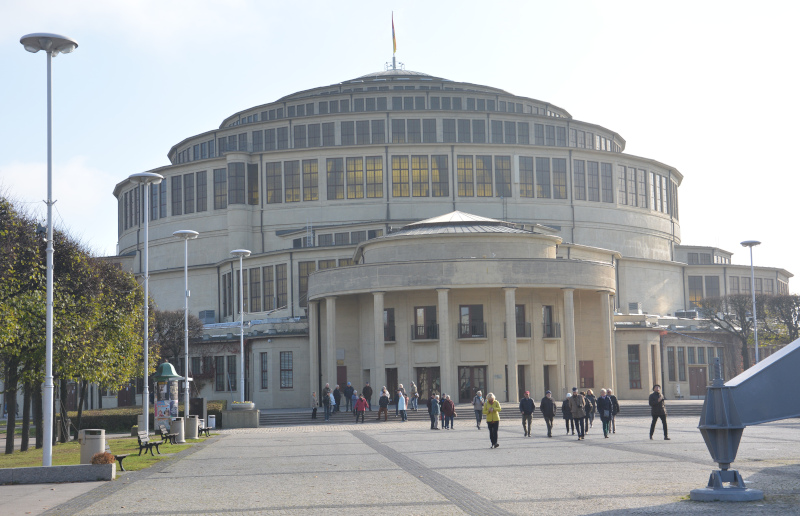
If you walk from the „iron needle“ towards the round building of the century hall, you will find the entrance a few meters to the right. It is definitely worth a visit, especially since behind it is the „multimedia fountain„, where in the summer season, music is choreographed to colorfully illuminated fountains in the evenings. In winter the water surface forms an ice rink.
Past the fountain, the Japanese Garden with watercourses, tree tops partly in bonsai style and meditative resting places is accessible. This garden was also established in 1913 and is open from April to October. Unfortunately, the traffic on the street Adam Mickiewicza disturbs the peace of the Japanese Garden a little, so take headphones for your meditation hour.
Wroclaw Zoo and Afrikarium
On the opposite side of the street from Zygmunta Wroblewskiego there is the Wroclaw Zoo with the Africanarium, which was founded in 1865 and has since undergone modern reconstruction.
To get to the Century Hall and the Wroclaw Zoo, you can take tram lines 10 and 4 heading east (Śródmieście) directly to the Stulecia stop. From the „Sand Island“ north of the city centre excursion boats leave in the summer season to the close vicinity of the Zoo and Century Hall.
Hydropolis Wroclaw – an ode to water

A special exhibition in Wroclaw is the modern Hydropolis, where the subject of water is treated in a very authentic hall – it is located in a former underground water reservoir of the municipal waterworks. This is quite fitting, especially since Wroclaw, with the arms of the Oder and several tributaries, is a city with a lot of water. In a central „round cinema“ a video impression introduces the theme by showing and describing the „birth“ of the earth from a cosmic fireball and the subsequent separation of water (subtitles in English).
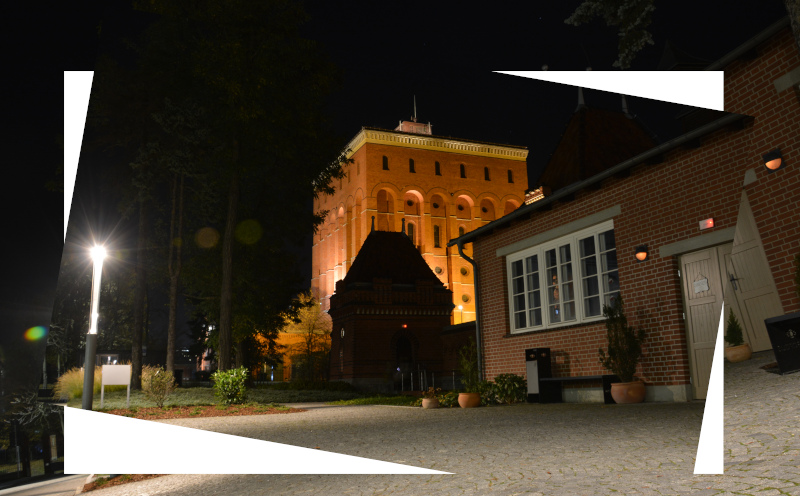
Life in the depths of the oceans
Then several Hydropolis exhibition focuses continue the path of water as the source of life. One section is dedicated to the „depths“, i.e. the deep sea and research in these almost unknown zones of the oceans. A replica of the deep-sea diving boat Trieste, where you can follow in the footsteps of Auguste Piccard down into the Mariana Trench, and the sometimes bizarre figures of deep-sea fish illustrate this unknown world.
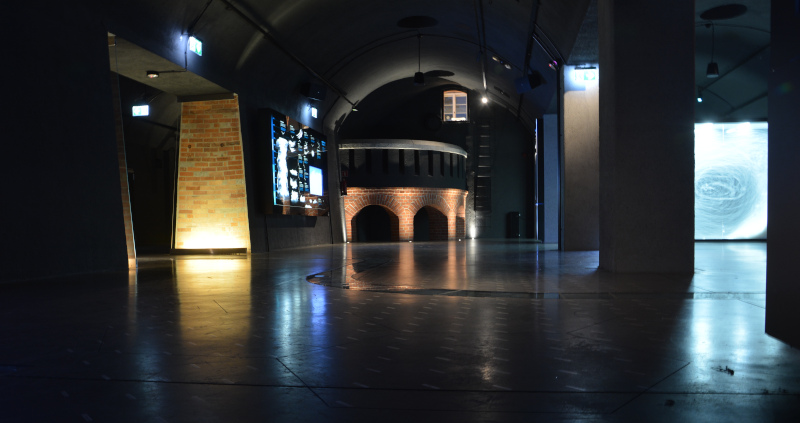
Other areas of the Hydropolis exhibition explain hydraulic engineering, drinking water purification and wastewater treatment as well as the water circuit, floods and weather phenomena. The possible changes and aggravations caused by climate change are taken into account and the effort required to provide clean and healthy drinking water is also explained as a subject of the Hydropolis exhibition.
A visit to the Wroclaw Hydropolis exhibition is worthwhile
My assessment – there is still a lot of potential for development, but in any case a catchy experience. A leaflet serves as an orientation guide, otherwise the object descriptions are in Polish and English. In the vestibule of Wroclaw Hydropolis Exhibition there are luggage lockers and generous wardrobes, space for playing children and a snack bar.
Take tram 3 eastwards to Plac Wróclewskiego, from there walk to Wálońska, which is called „Na Grobli“ behind the Olawa Bridge (Most Olawski). On the left side of the bridge you will find a special traffic feature – a cable car that does not lead to the top of a mountain, but shortens the way across the Oder for pedestrians. Further in the street you will reach the Hydropolis entrance.
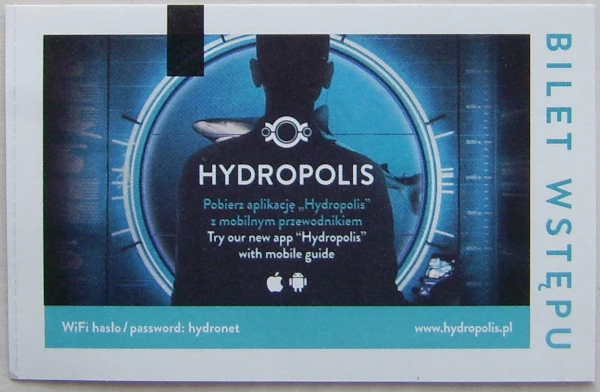
Other places worth seeing in Wroclaw
The royal palace with baroque garden
In the Royal Palace today houses the City Museum with an exhibition 1000 Years of Wroclaw, the royal chambers and the relaxing Baroque garden behind the palace building.
The quarter of the four religions
Just west of the palace, as part of the „Cultural Route„, is the „Quarter of the 4 Religions“, which, with 3 churches and a synagogue, is seen as evidence of the religious tolerance and openness of the city of Wroclaw. Many cultural events take place in the rooms.
For railways – friends – the Silesian Railway in model
You can find a model railway with the main focus on railway traffic in Wroclaw and Lower Silesia at Świbodzki – railway station southwest of the old town centre. The model includes about 510 m of rails, 15 trains and 60 wagons on a layout of 335 sqm. Świbodzki – railway station is one of the oldest stations in Wroclaw. The Polish Theatre also has a stage in the station.
New adress of model railway exhibition:
Sky Tower 1st floor
ul. Powstańców Śląskich 95
53-332 Wrocław
Wroclaw Dwarves – present everywhere
Where do the dwarfs of Wroclaw come from?
The dwarves in Wroclaw were once a more artistic form of action against the communist state regime and were used in the early 1980s at demonstrations in dwarf costumes or with dwarf pictures on the walls of houses. A cast iron dwarf was permanently installed in the city at that time.
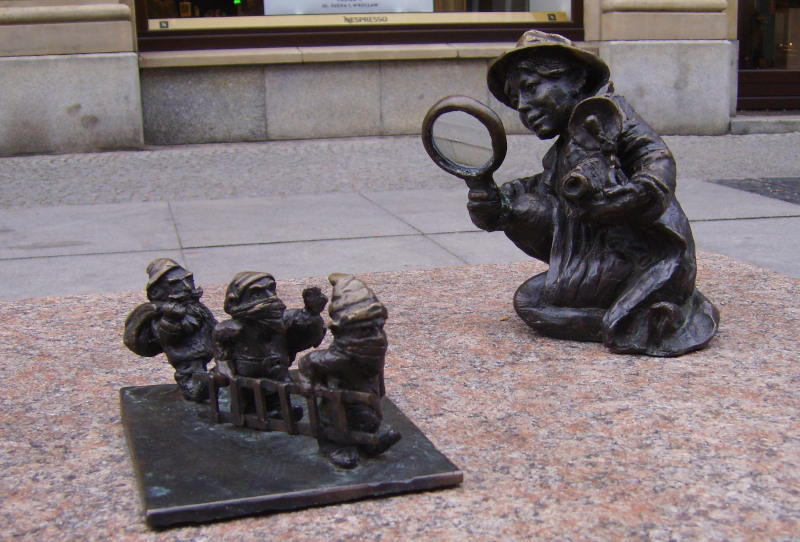
Students at the Wroclaw art academy took up the idea in the early 2000s and began placing dwarfs in various places in the city. Since these figures were well received by locals and tourists alike, artists were commissioned to expand the dwarf population, so that there are now over 300 of them spread throughout the city. Meanwhile 2 of the dwarves have also been discovered in the Saxonian twin city Dresden.
n Wroclaw, the dwarfs are often in the context of city historical events, special places, anecdotes and stories. However, many of Wroclaw’s dwarfs are also simply a playful and creative impetus for imagination – stories that viewers can make up. For this very reason, the Wroclaw Dwarfs offer visitors with children an incentive to go on a discovery tour with the little ones, to look for more Dwarfs and to keep the suspense high during a stroll through the city. Eight artists are involved in the creation of Wroclaw dwarfs with their workshops.
So today there are reading and guitar playing dwarfs, a dwarf – rocker, a university dwarf as a scholar at the university, a dwarf watching dwarfs with even smaller dwarfs……
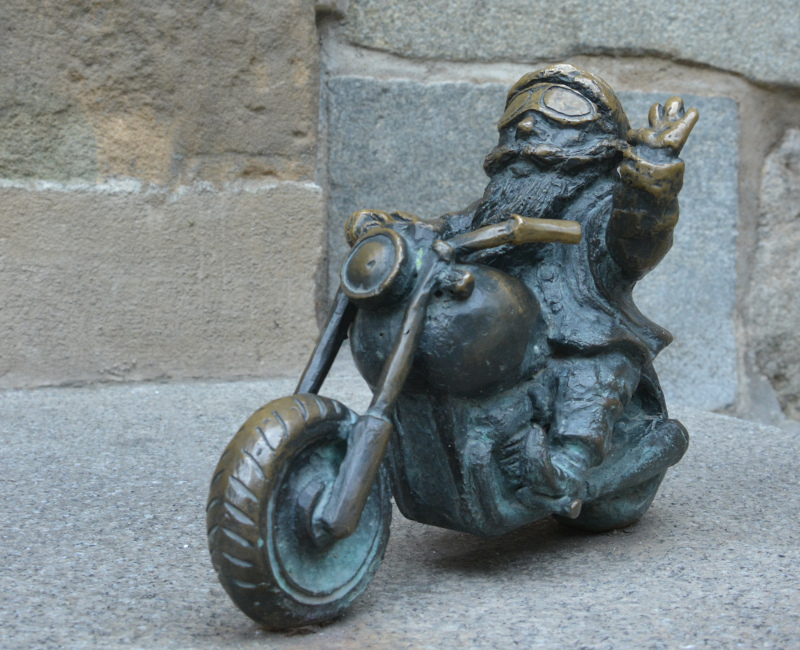
How do I go on a dwarf discovery tour of Wroclaw?
The Wroclaw Dwarfs have now become an independent sight of the city of Wroclaw, triggering joy of discovery and fantasy trips among children and adults, locals and guests of the city. … in the meantime, some of the Wroclaw dwarfs even go on tour and visit the twin cities of Wroclaw.
You can find an interactive dwarf map of Wroclaw under the keyword Krasnale on visitWroclaw.pl on the basis of the openstreetmap city map. (Just scroll down a little bit on the website) All dwarf figures are listed there and you can search by name. Unfortunately, so far only in Polish, although a large part of visitWroclaw is also available in English, for example, the map with other sights of Wroclaw. Perhaps the dwarf – city map will soon be supplemented linguistically. By the way, an illustrated map with the Wroclaw dwarfs on paper for children (but also only in Polish) can be bought at the Tourist Information Wroclaw at Rynek 14 (main market square).
In English you get here a .pdf – map of the Wroclaw dwarfs for download from visitWroclaw (in A3 – format, two-sided, about 5MB) [right click on the link and select „…save target as„]! The APPs about the dwarfs published so far are all in Polish and rather poorly rated.
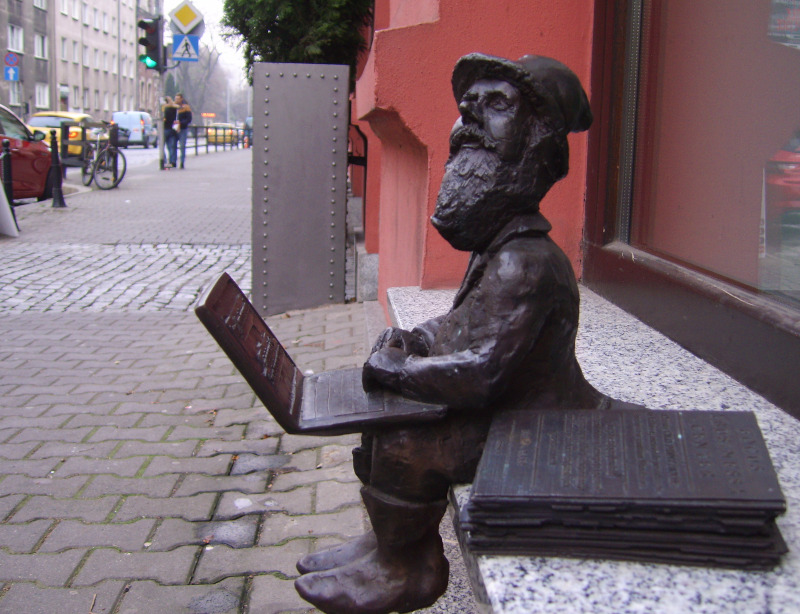
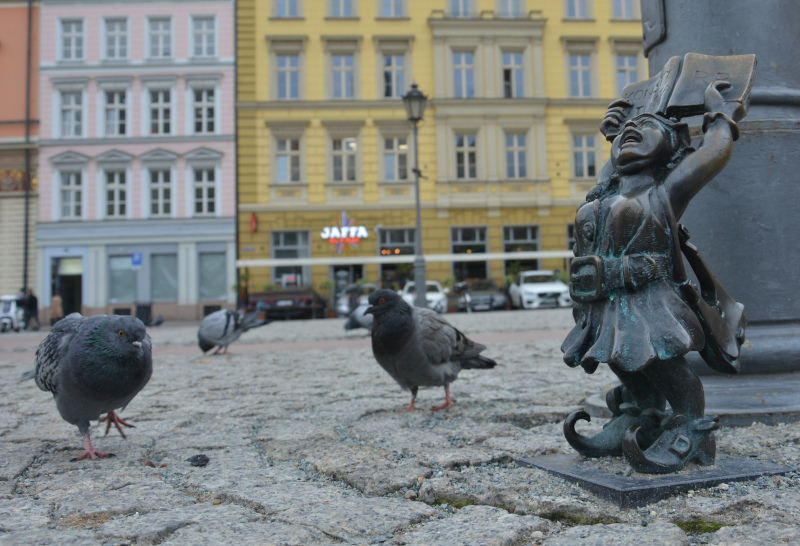
Music and theatre, festivals – Culture all year round
For cultural evenings, it is best to find out about the program schedules in advance. With the National Music Forum at the Place of freedom (plac wolności), the Opera, an Operetta, the Polish Theatre, the Philharmonic Orchestra Wroclaw and a puppet theatre, there is a large number of different venues, so that culturally, especially in the season, there should be no wish unfulfilled. In front of the music hall even a whole „dwarf – orchestra“ in full instrumentation plays for the people passing by.
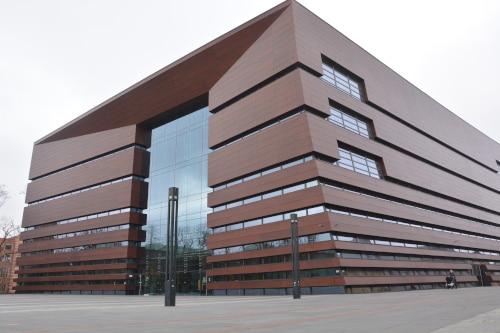
But also modern music and film art has its home in Wroclaw. For example, the Jazz Club Vertigo invites fans to sessions with Polish and international jazz greats. (incl. restaurant) There’s something going on at Vertigo almost every night – live music all week long! Oĺawska street 13; facebook: fb.com/vertigojazzclub
A number of festivals of the cultural scene determine the course of the year in Wroclaw. After the traditional Festival of Polish Classical Music in February, in spring there is the Jazz Festival „Jazz on the Odra“, the Port Wroclaw Literature Festival and the KAN Festival of Alternative and Independent Film.
In summer, the Nowe Horyzonty Film Festival, the Wroclaw NonStop Festival of Music, Art and Theatre and the Buskerbus – Street Theatre Festival follow.
In autumn there are two more theatre festivals – the international „Dialogue“ festival and a festival for one-person actors.
There is also an international film festival at different times and a series of organ and chamber music events in the summer.
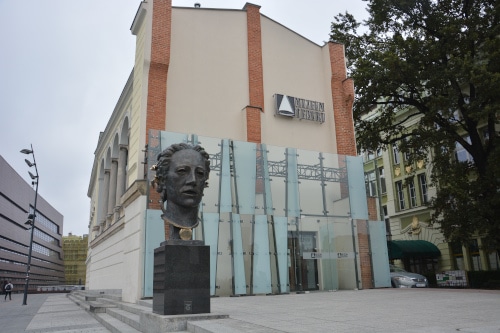
Travel tips for Wroclaw
Tourist information on site
The tourist information office has several locations. An office is located in the main station in the counter hall, right next to the entrance to the platform tunnel.
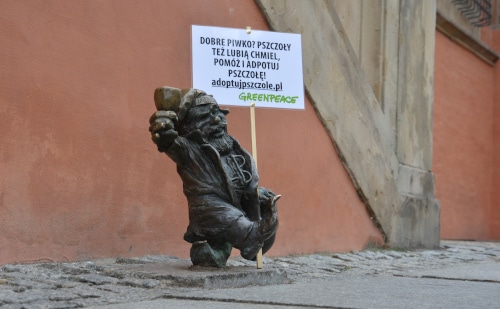
Another information office is located on the market square diagonally opposite the Town Hall (Rynek 14), the „Wroclaw Dwarf Information“ (Krasnale) in Sukiennice 12 (left of the Town Hall).
Best travel times and weather
The weather in Wroclaw is basically comparable with the Central European weather. Only it gets drier and in winter maybe a bit colder, because of the continental influence. The „wet“ months are distributed in summer – June to August has the highest rainfall, whereas July and August are also the rainiest months with an average of 10 rainy days. At the same time the temperatures in these two months are the highest with over 25°C.
Since there is always something going on in Wroclaw and many „indoor“ attractions tempt you, you can plan a nice trip there all year round and gather good impressions. It depends more on your interests. I have mentioned in advance what is possible and especially which festivals are annual highlights. Choose something and find out about the dates for the specific year, then the trip is worth twice as much!
The Timezone in Wroclaw
Central European Time applies in Wroclaw. This means a shift of +1 hour from Greenwich Meridian Time (GMT). At noon in London it is already 1pm in Wroclaw
Entry into Poland
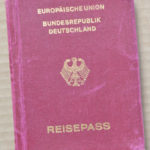
Poland belongs to the Schengen area of the European Union since 2007. Normally there are no border controls, if you arrive from EU countries. However, both the Poles and, when leaving the country, the Germans sometimes check them anyway. In Poland, too, there are occasional checks on identity cards. In this case it is necessary to take a valid identity card or passport with you. Travellers from outside the EU need a Schengen visa, unless a visa-free regime has been agreed with your country of origin.
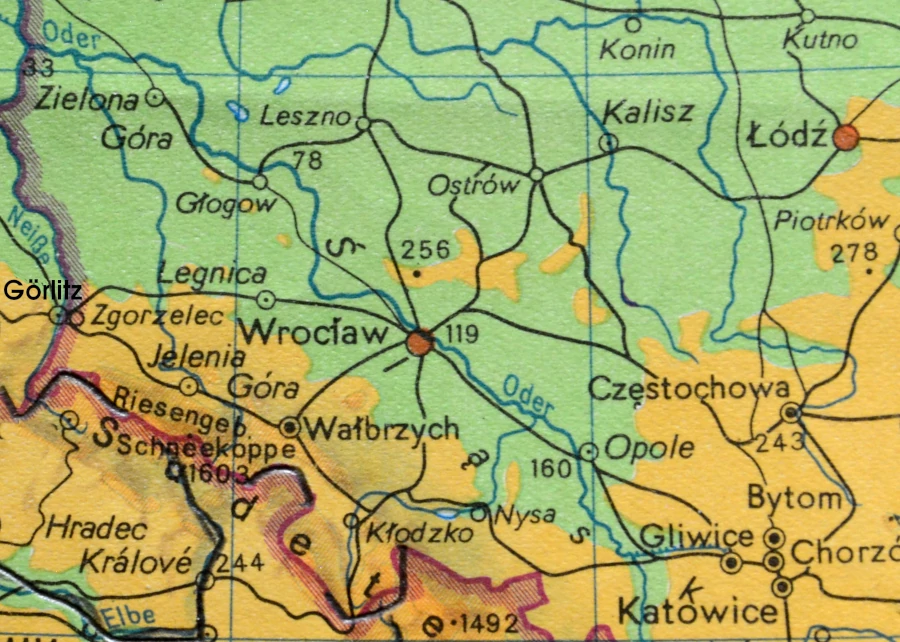
Journey to Wroclaw
… by long distance bus
The journey is well possible by bus and train. Various long-distance bus companies head for Wroclaw. From Western Europe this is mainly Flixbus with a regular service* especially via Dresden (several times a day), some lines of which continue via Leipzig to e.g. Brussels. Recently, a new long-distance bus terminal has been opened to the south – i.e. from the city centre of Wroclaw – behind the main railway station, under the „Wroclawia“ shopping temple. You can reach it by going under the station through the underpass and crossing the street at the southern end. The journey from Dresden Hbf. to Wroclaw with stops in Görlitz, Zgorgelec and 1-2 further stations in Poland takes about 4 hours. Tips for a pleasant journey with long distance busses here!
… by train arriving at the historical main station
Wroclaw railway station is a sight in itself, especially at night and in full illumination. But also inside, it is worth taking a look at the counter hall with its wood-panelled counter wall.
By train from Western Europe* is the journey possible, although the continuous long-distance train connections via Dresden and Görlitz unfortunately no longer exist. Here you only have regional trains to Görlitz and then the change to Polish regional trains.
From southern Germany and Austria you can travel via Prague or via Brno, for example. There are also direct trains* from Berlin.
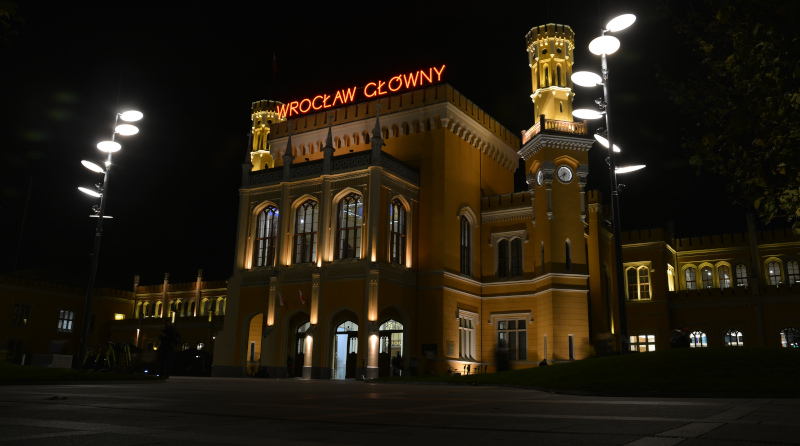
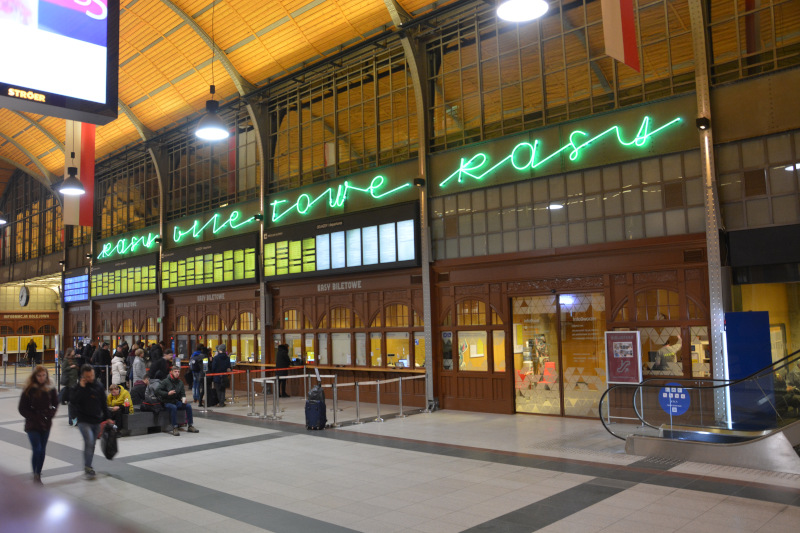
… by plane to Wroclaw
Wroclaw has its own airport, which is served by various airlines also from Western Europe. Among them from the UK are mainly Wizzair and Ryanair. The most importand airport in Poland is Warshaw airport with train and rental car services.
With easyjet.com* you can easily reach Kraków airport from several cities in the UK. There are very good train connections* between Kraków and Wroclaw and both cities are worth a visit.
… with your own car or a rental car
With your own car or a rental car* you can reach Wroclaw in about 2 to 2 1/2 hours from Görlitz (German eastern border). The arrival is via the well maintained motorway A4 (Eisenach- Erfurt – Dresden – Görlitz).
Please note: In Poland is all year round around the clock light obligation!
Local traffic in the city
Trams and city buses
Within Wroclaw there is a dense tram system, supplemented by city bus lines. Day tickets (24h) or multi-day tickets are worthwhile. The day ticket costs only about 3€. So you can use any tram. It is possible to buy tickets with a credit card on the tram or at vending machines at larger stops. The operating instructions can be changed to German and English. Unfortunately, I have no idea how the machines in the tram work, because there are no printed tickets – so you can get them somehow via app or similar. I am a bit „conservative“, I want to have something in my hand.
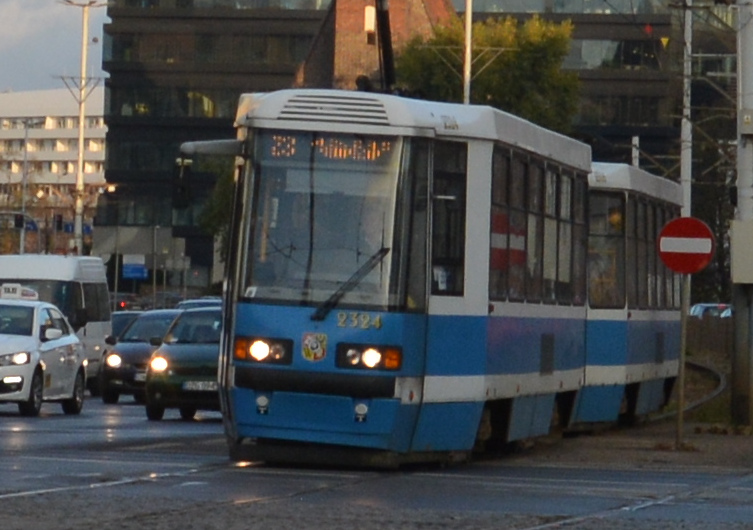
Near the bus stops there are often tobacco shops and kiosks „RUCH“, where you can buy a day ticket or single and multiple tickets for 12 PZl. You have to validate these on the first ride on the train.
A book about the Trams in Wroclaw*, especially their history is available.
Bike – City Bike and e-scooter in Wroclaw

In summer you can cycle well, especially as there are car-free cycle and footpaths along the Oder river on many sections of the route. At about 75 bike stations you can rent city bikes.
The e-scooters have also reached Wroclaw – if you like that, you will find scooters everywhere in the city. So far without chaos – the scooters are usually well parked, without hindering pedestrians or becoming a stumbling block.
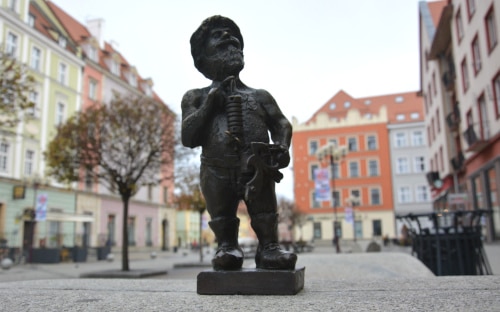
Accommodation in Wroclaw
Finding accommodation in Wroclaw (Breslau) is not difficult… apart from the agony of choice. Booking_com offers about 440 accommodations in the city centre alone. Among them are some hostels and similar shared accommodation, which are available for budget travellers.
But also individual travellers who want to stay in their own kingdom for the night will find good and inexpensive hostels in Wroclaw with different priorities.
Hotels in the old city of Wroclaw
One establishment that has received a lot of praise from visitors is the Grand City Wrocław*, only about 2 minutes‘ walk from Plac Solny and the market. This hotel with modern facilities in a historic building offers air-conditioned rooms, a restaurant, breakfast buffet, fitness area and, on booking, massages. Pets are allowed. Conference rooms can be booked for business clients.
About 500m from the market place the PURO Wrocław Stare Miasto* (old town) awaits your visit. The ultra-modern rooms are soundproofed, air-conditioned and equipped with smart service control panel for lighting and climate control. Each room has a laptop safe. Coffee is available free of charge at an espresso machine. The parking spaces in the multi-storey car park are limited and very narrow, there is another car park nearby.
If you want to end your day with fitness, sauna or a round in the pool, the Qubus Hotel Wrocław* is the right place to be. This modern hotel with indoor pool is located right next to the church of St. Mary Magdalene, about 150m from the main market. The hotel is especially praised for its breakfast buffet with many regional offers, which are very digestible for sporty fit visitors. Pets are allowed. Conference rooms can be booked.
The Best Western Premier Hotel City Center* is located not quite in the old town centre, but close to the railway station (100m). Anyone travelling with a lot of luggage will appreciate this, especially since after checkout storage for the rest of the day is no problem. Some rooms are equipped for mobility-impaired and mobility-impaired guests. All floors are accessible by elevator. The proximity to the train station also qualifies this hotel for meetings and conferences. The Opera House, the National Music Forum and the Capitol Musical Theatre are within easy reach of the Hotel City Center.
Apartments and holiday flats
A large part of the accommodation in Wroclaw are apartments or holiday flats. These are often rented out well-equipped in apartment buildings close to the city centre.
The apartment Old Town Rynek* is located directly at the Old Town Market in Wroclaw. It offers space for max. 6 persons, for 4 in two bedrooms plus sofa bed in the living area. A fully equipped kitchen, a comfortable and spacious living area and a bathroom with shower are available.
The Elzbieta Locum / Wroclaw Market* is an apartment in an old building, which offers a good mixture between appreciation of the old building structure and modern equipment elements. In the apartment there is room for 2 persons in the bedroom, extended by a sofa bed in the living area for another 2 persons. The location is excellent, in the Oderstraße directly at the market and very close to Wroclaw main sights. However, parking spaces are only available for public use in the area and may be subject to charges.
The LoftApart* is located about 500m away from the market in an old town house. This apartment is very large and can accommodate 2 persons each in three bedrooms. If you expect even more visitors, there is room for 4 more people on two sofa beds in the living area. There is a bathroom with shower and a fully equipped kitchen area in the large living room. Parking is only available in the public car park or in the car park opposite for 100 PZl per day.
Dining in Wroclaw
In Wroclaw there are many ways to eat – from zapiekanki (half bagette with champingnon and gratinated with cheese) on the hand to a sophisticated dinner. I have three recommendations:
vegan snack – Restaurant VEGA
The vegan restaurant VEGA is located directly at the market, past the town hall on the right in one of the houses in the middle square. (Rynek corner of Sukiennice lane – main market square)
It is very popular, a constant coming and going, but it goes fast and also offers enough space over two floors. The dishes are tasty and plentiful. The VEGA is self-service – you go to the counter, choose something and order. What is quick, you get straight to your hand, for preparations you have to wait and watch out when your vegan meal is called.
This is not the place to dine in peace. It is accepted as a snack by the locals – students, employees of the surrounding offices and shops, people passing through on their way through town etc.
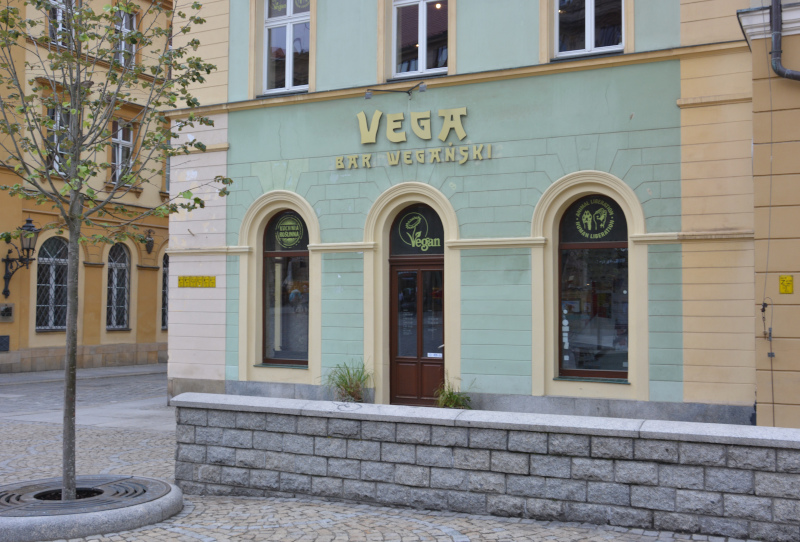
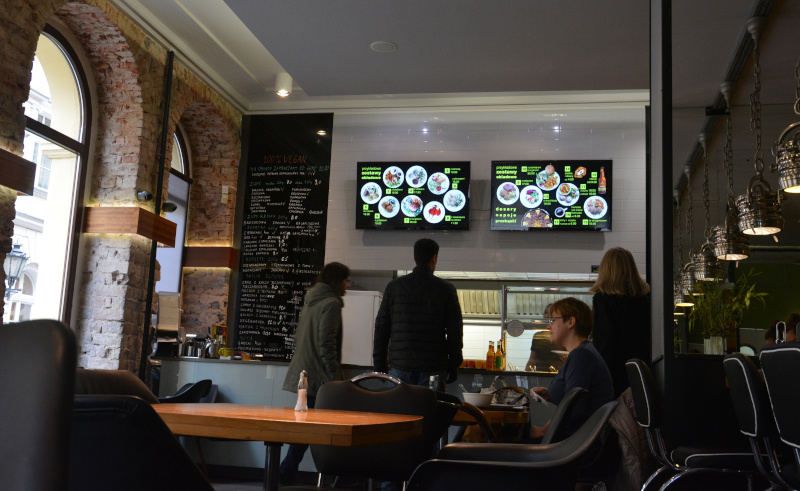
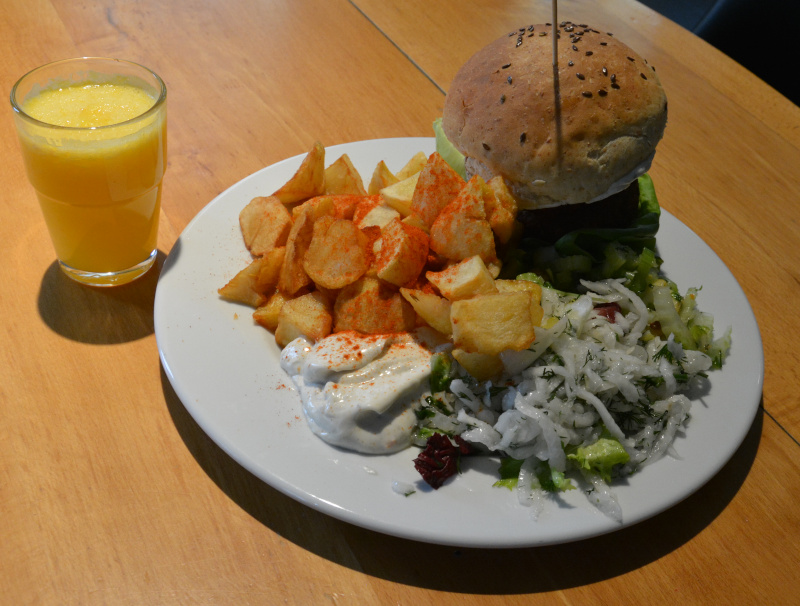
I got the recommendation from two activists from Greenpeace Wroclaw, who on that day equipped the dwarves with demo signs to demonstrate against bee deaths also in Poland. I can only share their advice! By the way, I got the vegan burger because of a misunderstanding, but it tasted great and I was more than full for the day. Please clear the dishes yourself. The toilets are in the upper floor.

U Gruzina
There’s Georgian Streetfood. So another quick snack for the eventful sightseeing tour through the city and maybe an incentive to visit a country even further east ;-). I went to the corner of Odrzanska and Nowoźnica, just across the street from the butcher’s alley „Jatki“.
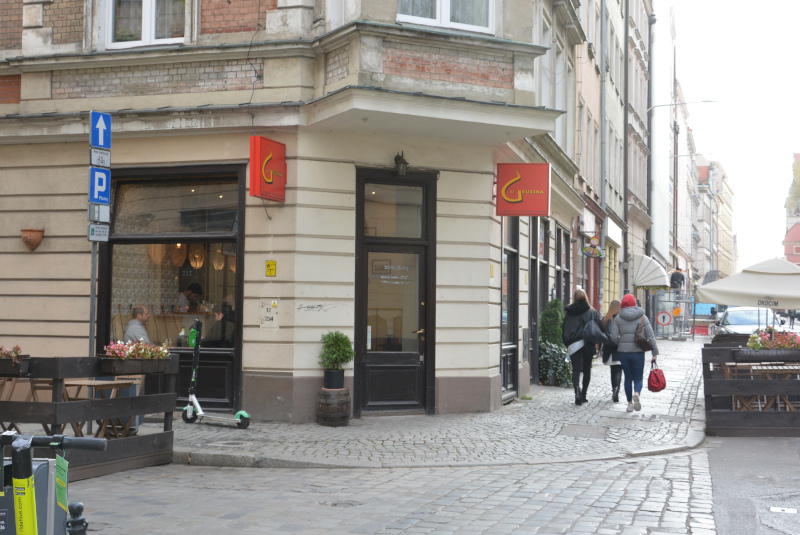
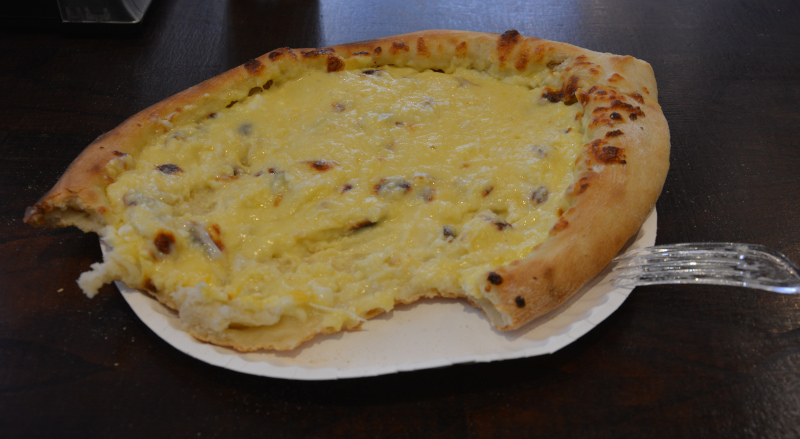
There are very tasty relatively simple dishes on the menu and you can also sit down to eat 🙂 I was recommended a kind of pide (dough boat), which is baked in the oven on site. Right after baking I was allowed to watch how egg, butter and a cheese were mixed together on the hot dough, which immediately melted and ran due to the heat of the dough. It tasted great and I was saturated, rested and strengthened for the next tour.
Deficiency: The „streetfood“ in the subtitle is interpreted too „American“, therefore there is no proper crockery and cutlery, but only throw away – cardboard plates and plastic fork. Even if you find a place and eat on the spot. This is a real pity, because otherwise this snack is much more stylish than the usual kebab stands. Unfortunately no toilet available.
Good breakfast – Vincent Bakery and cafè (Now: Etno café)
Since good breakfast is important to me for the start of the day, here is a tip for it: The Vincent! (update: It’s called now Etno Café)
A café with overflowing counters – displays, offers from sweet to hearty and good coffee.
Many Poles who come in and out in flocks there eat egg with ham and bacon or similar „strong“ dishes for breakfast. But there are also sweet pastries. The front area on the right is dominated by the counter with its constantly fed queue. On the other side there are quieter places, partly on „bar stools“, but also comfortable armchairs.
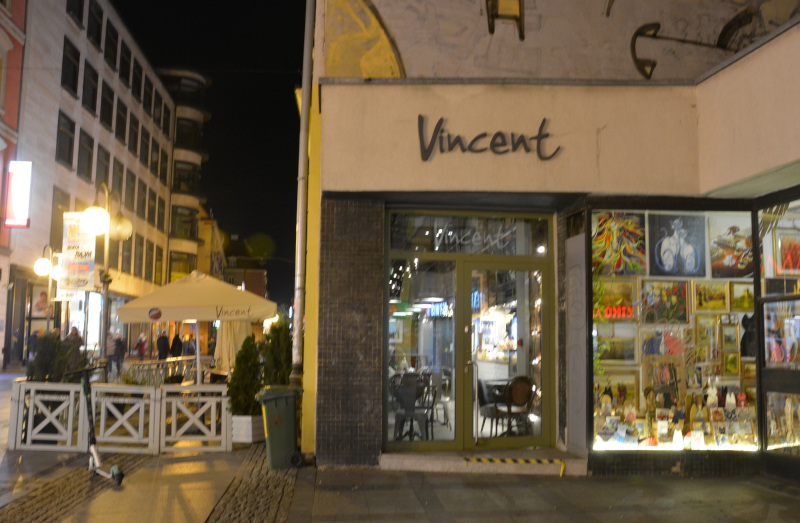
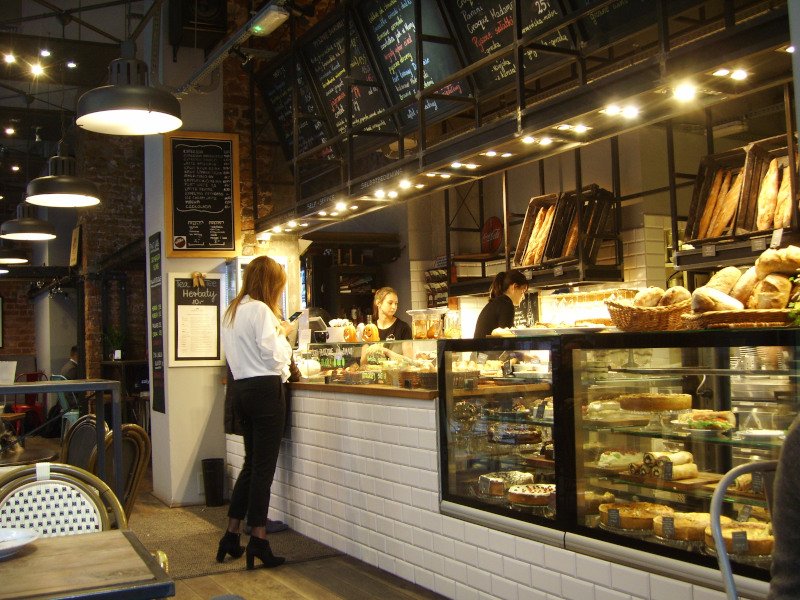
Polish Money
The Polish zloty is the currency used in Poland. 1€ corresponds to approx. 4.25 PZl. You can get the Zloty easily with MasterCard or credit cards at bank machines. Fees depend on your bank. In many shops you can pay by credit card, also local transport can (somehow) be paid by credit card at the machines.
Literature, Wroclaw Guide, Citymap….
If you would like to have a Wroclaw city map with the Polish and the old German street names in your hand, the Höfer city map Wroclaw / Breslau* is a good choice. This map is on a scale of 1 : 16500 and shows in great detail where you are currently moving or where you would like to go. For a better view with so many symbols and designations, a magnifying glass is included with the map. A rough overview map of Poland is also included. You can also order by wordery, if available again*.
An guide-book to Wroclaw* in english should be available here.
A travel guide with tips from a local: Greater Than a Tourist- Wroclaw*
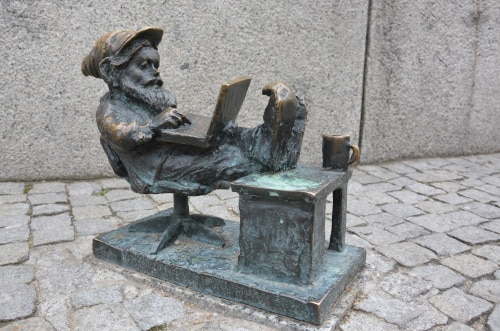
The interesting history of the cities of Lwow (Lemberg) and Wroclaw (Breslau), whose populations were almost completely replaced after the end of the Second World War and due to the Potsdam Agreement. LVIV – Wroclaw, Cities in Parallel? Myth, Memory and Migration, C. 1890-Present*
When the German Breslau became the Polish Wroclaw, over 600,000 people had to leave the city and were replaced by resettlers from the Polish eastern territories. The book „uprootet. How Breslau became Wroclaw during the century of expulsions“ by Gregor Thum* examines the consequences, the cultural and psychological consequences of the resettlement after the end of the Second World War. The uprooted new Polish citizens found themselves in a war-torn environment. A myth was invented that Wroclaw had a long Polish history – German prehistory was largely ignored. Only now, with the unification of Europe, is this part of the city’s history being rediscovered and integrated into a new view of history. ebook, also available as paperback and hardback*.
The architecture in Wroclaw is influenced in many ways – by Poles, Hungarians, Germans and Czechs. There have been trends and developments over centuries. The book Wroclaw: Architectural Guide* is dedicated to the architecture in the city of Wroclaw, with a special focus on the various tenements. The first of them were already built in the Middle Ages, in the Renaissance.
… and music of Wroclaw
Wroclaw is also a city of music. Several ensembles provide for a varied concert offer in the city on the Oder. For a first impression or to listen to them after your visit to Wroclaw here are two offers:
The Salzburg Marien – Mass by Mozart*, recorded with the Wroclaw Baroque Ensemble.
The Christmas Mass by Franz Xaver Richter*, recorded with the Wroclaw Baroque Orchestra and the Wroclaw Philharmonic Choir.
Invite your friends to the search of Wroclaw dwarfs – Share on social media!
Did you like the article about Wroclaw / Breslau and the dwarfs? Then I would be happy about a comment and I think it’s great if you share the link on your social media channels!
A little summary – the Wroclaw FAQ
Wroclaw / Breslau is located in the Dolny Ślask Voivodeship (Lower Silesia) in south-western Poland on the upper reaches of the Odra River.
Yes, Wroclaw was the former german city Breslau in the Silesian Region.
In October 1944 the RAF starts bombing Breslau. After the WW2 the city was up to 80% destroyed. But this was not because of airstrike then because of ground battles. Hitler declared the city Breslau, the german name of Wroclaw, to a fortress and so the battles where gone up to the last bullet.
After World War II, several state borders in Europe were shifted by the victorious nations in the Potsdam Agreement. In the east, Poland lost large parts of its territory to Ukraine and thus to the Soviet Union. East Prussia, parts of Pomerania and Silesia were separated from Germany, and Poland, or in the north of East Prussia, were also assigned to the Soviet Union. Wroclaw is located in Silesia and thus became Polish.
The largest river flowing through Wroclaw is the Odra. In addition, Widawa, Śleza, Olawa and, on the outskirts, the Bystrzyca flow through Wroclaw. The rivers and tributaries form 12 islands in the city area, which are connected by over 300 bridges.
Wroclaw is rich in culture! From the music forum to theater and opera, the classics are represented, a jazz club, smaller theaters and other cabaret can be found in the city. Railroad enthusiasts will find a model train exhibition in the old Swiebodzki station. The old town invites to stroll, a promenade runs along the Oder River with a beautiful view of the Oder islands and the cathedral. In the east of the city there is the Centennial Hall, a multimedia fountain, the Japanese Garden and the Wroclaw Zoo. Also worth seeing is the Hydropolis Wroclaw exhibition in an old underground water reservoir. Several church towers offer views over Wroclaw. It is also exciting to go in search of Wroclaw dwarfs, who poke fun all over the city, delighting visitors and locals alike.
Wroclaw has a number of accommodations of various levels. Among them are good hotels, guesthouses and apartments or private rooms.
Note on *advertising links
Some links, e.g. to bus and train or hotels are so-called affiliate links marked with *. If you click on such a link and buy or book something from these providers, sonnige pfad blog receive a small commission for the brokerage. Nothing will be more expensive for you, because the commission is already included in the price.
Sorce of photos : product photo – producer / vendor
